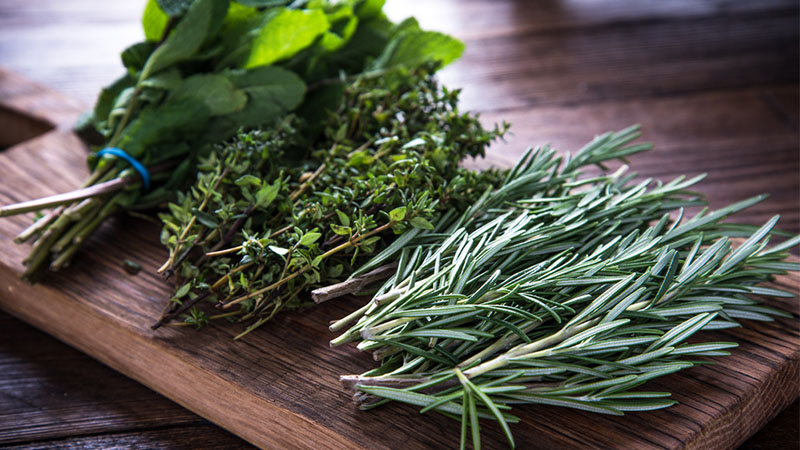Hands up who has tried to do some gardening in Hong Kong and ended up with wilted plants? Whether you want some basil on a windowsill, a few plant pots on a balcony or rooftop space, or even a proper outdoor garden, here are some tips on how to grow herbs or vegetables that will hopefully have you on the path towards a bumper crop!
What to plant?
A potful of healthy herbs or colourful veggies can look great in a room. Having said that, most of us grow them not just because they’re pretty, but also to use them in cooking.
So, what are the best things to plant in your home? The ones you’re most likely to add to a recipe!
Herbs:
If the kitchen isn’t your thing but you love some fresh mint in a mojito, opt for mint. (It’s among the easier herbs to grow, too.) Otherwise, you could try parsley, basil, bay leaves, thyme, oregano or any other common herb used in cooking. Prefer Asian flavours? Go for the likes of curry leaf or Thai basil.
Vegetables:
You’ll need to keep in mind Hong Kong’s two distinct growing seasons: from the beginning of autumn to mid-spring is the cool season. Veggies that work well in this period include leafy greens like lettuce, kale and spinach, along with tomato, beetroot, cauliflower and broccoli. The warmer months, meanwhile, are better for pumpkin, eggplant, cucumber and chillies. Keen on some fruit instead? Try strawberries (best in winter).
One packet of herb or vegetable seeds will likely set you back around $20 or so. (One tip: look on the packet for the “time to maturity” of the plant. If you’re impatient, go for something with a short growing cycle!) You can also grow herbs and veggies from existing potted plants or cuttings, if you prefer: just be sure that you make a hole large enough in your soil mix for the plant and all its roots. For a potted herb, tap the plant out of the container, loosen some of the root ball at the bottom to encourage the roots to expand outwards, than place it in your soil and water.
If you’re keen, do some research into growing from vegetable cuttings. Methods vary widely, from avocado seeds to ginger roots to leftover lettuce.
Pots and placement
Herbs and veggies need sunlight – and quite a bit of it. So, if you’re in an apartment, you’ll need a balcony or an indoor area that receives at least four hours of direct sunlights for most herbs, up to to six or eight hours for veggies. We’re not going to lie: in Hong Kong, this can be a tough ask, as even a sunny windowsill can have light blocked by surrounding buildings for much of the day.
So, before you decide to start, it’s a good idea to test out a likely growing space by checking a few times over the course of a morning and afternoon to see how brightly lit it is. If the light is too intense in the middle of the day or early afternoon, use shade cloth or fabric to cut out a percentage of rays. Also, on balconies or rooftops, be sure your pots are protected from the wind, and aren’t placed in an area where water can run off from above after heavy rain. It’s very easy to drown a new plant this way!
If you don’t have a space that gives you the required hours of sunlight, there are some solutions: microgreens grow well even in shade, for example. Also, there are plenty of vegetable varieties that aren’t as dependent on direct sunlight as others – a quick google search should have you sorted.
Herbs:
As much as we love the look of one large garden bed festooned with every type of herb, individual pots for different herbs are the best approach. And make sure each pot has enough space of its own. This helps air to circulate, and it can help stave off disease, too. A rack for a series of pots is a good idea – they’re available at every garden/outdoor store.
Vegetables:
Veggies generally require more room than herbs, so you’ll likely need deeper planter boxes rather than small pots. Anything up to half a metre long and around 20cm deep is good. Because of this bigger size, the containers will be heavier when filled with soil and water. So, choose your planting location carefully as it’ll be harder to move things around. There are plenty of how-to guides online for constructing your own veggie pots and planters.
It’s also a good idea to rotate your pots and containers from time to time – this is especially true of balconies, where sunlight tends to come in at an angle rather than directly overhead like in an outdoor garden.
Getting the potting mix right
Your best bet for a potting material is a mix of a regular soil potting mix along with what’s known as LECA (it stands for “lightweight expanded clay aggregate”). These are porous pellets that help water to drain away from your growing material, which means the roots dry out quickly after watering. Add a little compost from kitchen scraps, if you can, and you have a great base for growing herbs. Composting buckets for your kitchen are readily available and easy to use.
If you’re growing climbing plants such as tomatoes, you’ll need to add stakes to the soil. Bamboo stakes work well. Note that tall plants are more susceptible to wind, so you’ll need to be vigilant in typhoon season.
When to water
Most herbs and vegetables should be watered once a day – if they’re in a particularly sunny or breezy spot, you may need to do more. However, different plants require different quantities. (Basil and mint tend to need more water, for example.) So, before watering, feel the soil or potting mix with your fingers for moisture below the surface. Only water when it’s slightly on the dry side.
When and what to feed
Herbs:
Herbs tend not to need as much feed as other plants, but it’s still fine to add some nutrients every few weeks. A slow-release organic fertiliser should do the job. For a foliar spray that you use on the leaves themselves, it’s a good idea to stick with natural materials – you’re going to be eating those leaves, after all! One option is diluted seaweed extract.
Vegetables:
Every couple of weeks is a rough rule of thumb for feeding veggies. You could use the same slow-release fertiliser mentioned above, or why not make your own organic feed at home? Banana water (or “banana tea”) is an easy one. Just soak a couple of banana peels in half a litre of sealed water for a couple of days. Throw away the peels, and feed your plants with the water.
Final tips
- You’ll likely spend a portion of each day starting at your plants to check on their growth! While you’re at it, keep an eye out pests, and also for weeds in the soil, and take appropriate action if you see either.
- If you don’t have much room at home, or you prefer a “system” that will help you get started more easily with growing, there are options available, from vertical gardening kits to hydroponics.
- Don’t give up on your first attempt to grow herbs and vegetables! Everyone experiences a misfire or two. With some subtle tweaks to your method, we’re sure you’ll be on your way to tossing a few home-grown ingredients into your dinner recipe. Good luck!
For more helpful tips on gardening in Hong Kong and more, head to our Living in Hong Kong section.






